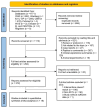Efficacy and safety of wet cupping in the treatment of neurodermatitis: a systematic review and meta-analysis
- PMID: 39748922
- PMCID: PMC11693718
- DOI: 10.3389/fmed.2024.1478073
Efficacy and safety of wet cupping in the treatment of neurodermatitis: a systematic review and meta-analysis
Abstract
Background: Neurodermatitis is a chronic skin condition characterized by intense itching and skin thickening due to neurological dysfunction. Its persistent nature poses a challenge to effective treatment, significantly impacting patients' quality of life. Wet cupping therapy is increasingly being used in clinics to manage neurodermatitis, so it is imperative to assess the evidence regarding its effectiveness and safety.
Objective: This review aimed to evaluate the efficacy and safety of wet cupping therapy in patients with neurodermatitis.
Methods and analysis: Randomized controlled trials (RCTs) investigating wet cupping for neurodermatitis were identified through searches of eight electronic databases and three clinical trial registration platforms from inception to March 2024, using predefined search terms. Included studies underwent quality appraisal using the Cochrane Collaboration's Risk of Bias Assessment tool. The quality of evidence was assessed independently by two reviewers using the Grading of Recommendations Assessment, Development, and Evaluation System (GRADE). Meta-analysis and publication bias assessment were conducted using ReviewManager 5.4 and STATA 17.0 software, respectively.
Results: This review encompassed 19 studies, comprising 6 types of comparisons and involving 1,505 participants. The findings revealed no significant difference in the total effective rate between wet cupping alone and high-potency steroids (n = 269, RR = 1.13, 95% CI [0.90, 1.41], p = 0.29, I2 = 83%). However, wet cupping combined with medication or moxibustion exhibited superior efficacy compared to medication alone (n = 272, RR = 1.28, 95% CI [1.16, 1.41], p < 0.00001, I2 = 43%) and (n = 534, RR = 1.22, 95% CI [1.14, 1.30], p < 0.00001, I2 = 0%). Wet cupping groups demonstrated lower recurrence rates (n = 266, RR = 0.31, 95% CI [0.16, 0.60], p = 0.0005, I2 = 0%) and a reduced incidence of adverse events (n = 673, RR = 0.44, 95% CI [0.21, 0.90], p = 0.02, I2 = 36%). Furthermore, wet cupping alone or combined with moxibustion effectively lowered the levels of inflammatory factors compared to medication: TNF-α (n = 120, MD = -6.99, 95% CI [-8.13, -5.85], p < 0.00001, I2 = 0%), IL-1β (n = 120, MD = -5.28, 95% CI [-6.91, -3.65], p < 0.00001, I2 = 48%), and IL-6 (n = 180, MD = -8.61, 95% CI [-13.24, -3.99], p = 0.0003, I2 = 81%).
Conclusion: The efficacy of wet cupping therapy is comparable to that of high-potency steroids. Its combined use with medication or moxibustion appears to enhance effectiveness, reduce recurrence rates, and improve safety. However, due to the overall low grade of evidence for the identified outcomes and poor methodological quality, caution is advised when interpreting and applying these findings in clinical practice.
Systematic review registration: https://www.crd.york.ac.uk/prospero, identifier: CRD42024524398.
Keywords: efficacy; lichen simplex chronicus; meta-analysis; neurodermatitis; systematic review; wet cupping.
Copyright © 2024 Zhai, Hui, Jiang, Ding, Cheng, Xing, Zhai and Zhang.
Conflict of interest statement
The authors declare that the research was conducted in the absence of any commercial or financial relationships that could be construed as a potential conflict of interest.
Figures









Similar articles
-
Cupping therapy for patients with chronic urticaria: A systematic review and meta-analysis.J Integr Med. 2020 Jul;18(4):303-312. doi: 10.1016/j.joim.2020.05.004. Epub 2020 May 28. J Integr Med. 2020. PMID: 32534938
-
Wet cupping therapy for treatment of herpes zoster: a systematic review of randomized controlled trials.Altern Ther Health Med. 2010 Nov-Dec;16(6):48-54. Altern Ther Health Med. 2010. PMID: 21280462 Free PMC article.
-
Auricular acupressure for constipation in adults: a systematic review and meta-analysis.Front Physiol. 2023 Oct 16;14:1257660. doi: 10.3389/fphys.2023.1257660. eCollection 2023. Front Physiol. 2023. PMID: 37908337 Free PMC article.
-
The effectiveness of cupping therapy on low back pain: A systematic review and meta-analysis of randomized control trials.Complement Ther Med. 2024 Mar;80:103013. doi: 10.1016/j.ctim.2024.103013. Epub 2024 Jan 5. Complement Ther Med. 2024. PMID: 38184285
-
Evaluation of efficacy and safety for compound kushen injection combined with intraperitoneal chemotherapy for patients with malignant ascites: A systematic review and meta-analysis.Front Pharmacol. 2023 Mar 3;14:1036043. doi: 10.3389/fphar.2023.1036043. eCollection 2023. Front Pharmacol. 2023. PMID: 36937874 Free PMC article.
References
-
- Werfel T, Aberer W, Augustin M, Biedermann T, Fölster-Holst R, Friedrichs F, et al. . Atopic dermatitis: S2 guidelines. Journal der Deutschen Dermatologischen Gesellschaft = Journal of the German Society of Dermatology: JDDG. (2009) 7:S1–S46. doi: 10.1111/j.1610-0387.2009.06972.x, PMID: - DOI - PubMed
-
- Tang Y, Yao Z. Research and therapy Progress on the mechanisms of pruritus in atopic dermatitis. Med J Peking Union Med College Hospital. (2022) 13:473–9. doi: 10.12290/xhyxzz.2021-0747 - DOI
Publication types
LinkOut - more resources
Full Text Sources

